#sir edward burne jones
Explore tagged Tumblr posts
Text

Pilgrim at the Gate of Idleness
Artist: Sir Edward Coley Burne-Jones (English, 1833-1898)
Date: 1884
Medium: Oil on canvas
Collection: Private collection
Description
The theme of the Romaunt of the Rose occupied Burne-Jones intermittently for over twenty years. The present painting was begun in 1874 and substantially finished in 1884. The Heart of the Rose, created as a pendant, was begun in 1889. Both paintings remained in the studio and were taken up again by the artist in 1892, following a period of illness, and completed in time for the New Gallery exhibition in 1893.
#painting#pre raphaelite brotherhood#artwork#oil on canvas#fine art#oil painting#english culture#english art#landscape#pilgrim#gate of idleness#male figure#female figure#drapery#literature#poetry#the heart of the rose#trees#door#pre raphaelite movement#sir edward burne jones#english painter#european art#19th century painting
42 notes
·
View notes
Text

Cupid's Hunting Fields
Artist: Sir Edward Burne-Jones (English, 1833-1898)
Date: 1895
Medium: Gouache, with watercolor and gold and silver paints on ivory wove paper, laid down on linen canvas
Collection: Art Institute of Chicago, Chicago, IL, United States
#mythological art#painting#classical mythology#cupid#hunting field#mythological scene#hunter#arch#arrow#wings#female figures#gouache#watercolour#pre-raphaelite style#sir edward burne jones#english painter#english art#19th century painting#fine art#artwork
27 notes
·
View notes
Text

The Mirror of Venus
Artist: Edward Burne-Jones (English, 1833–1898)
Date: 1898-1875
Medium: Oil on canvas
Collection: Calouste Gulbenkian Museum, Lisbon, Portugal
Description
A member of the pre-Raphaelite movement that was formed in England in 1848, Sir Edward Burne-Jones became one of the leading figures in a new trend, known as Aestheticism, that emerged in the 1860s. This composition can be seen as an exaltation of ideal beauty, bringing the atmosphere of the painting into alignment with a perspective shared by late Victorian art.
The painter employs minimum of narrative elements, creating a linear arrangement of poetic and oneiric figures clad in pseudo-classical clothing in the manner of a Greek-inspired frieze. Rather than aiming for a formal stylistic resemblance, Burne-Jones seeks to create a general affinity with a Renaissance atmosphere. In a manner clearly suggestive of the Quattrocento, and Botticelli in particular, the work gives precedence to the decorative harmony of the whole and deliberately evokes a sense of nostalgia for the past.
Like The Bath of Venus, which also belongs to the Gulbenkian Collection, the composition derives from an illustration intended for The Hill of Venus, part of William Morris’s poem The Earthly Paradise, which was inspired by the medieval legend of Tannhäuser.
#venus#english artist#sir edward burne jones#aestheticism#poetic#goddess#landscape#mirror#roman mythology#goddess of beauty#desert#pool of water#pre raphaelite movement#esthecism#mythological art#pre raphaelite brotherhood#english art#pool#reflection#european art#19th century painting
3 notes
·
View notes
Text
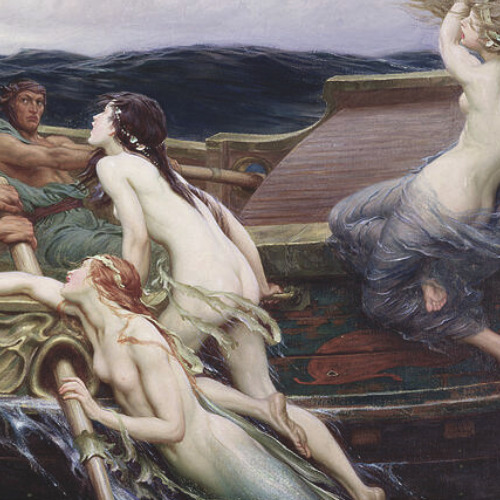


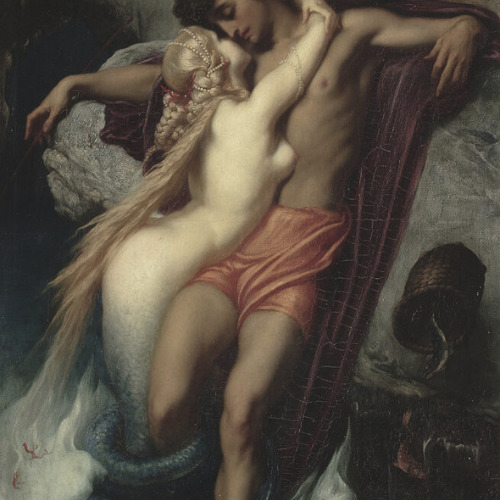
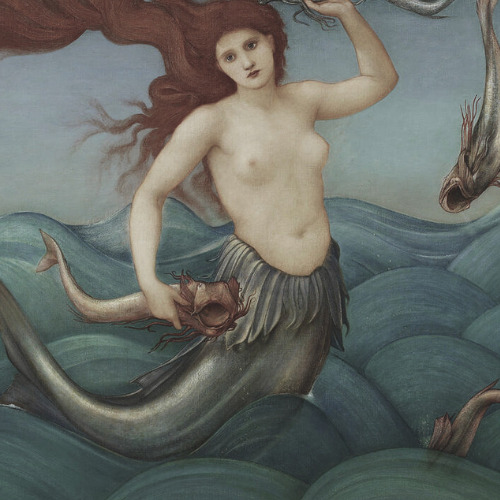

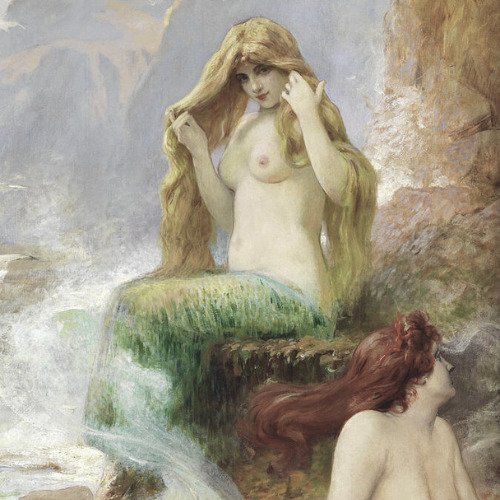
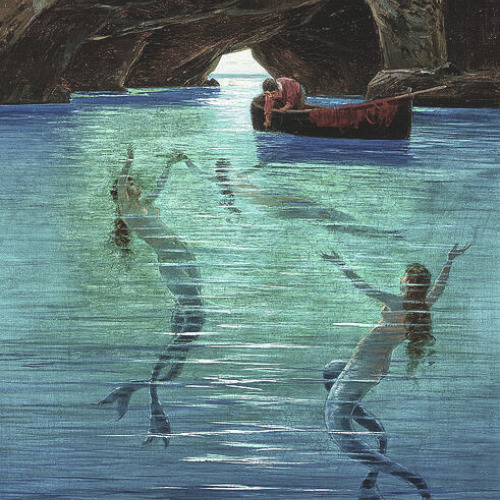

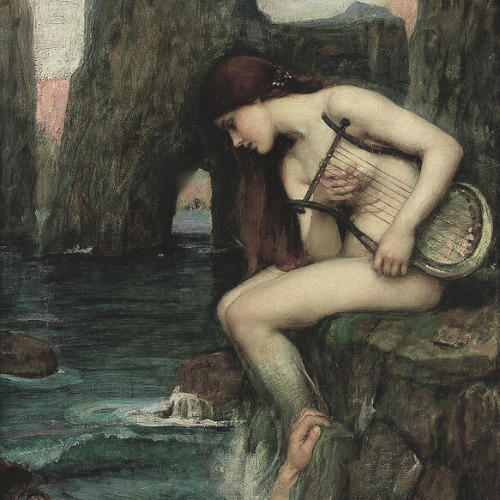



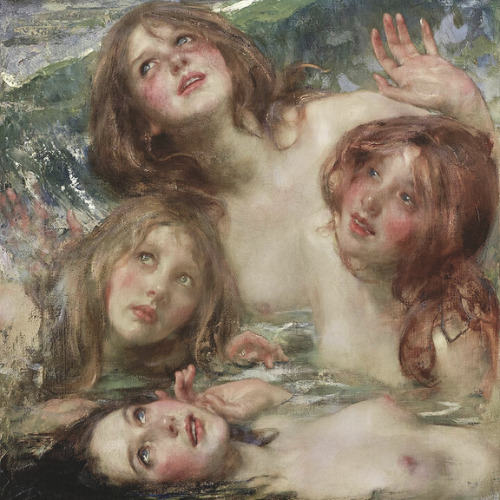
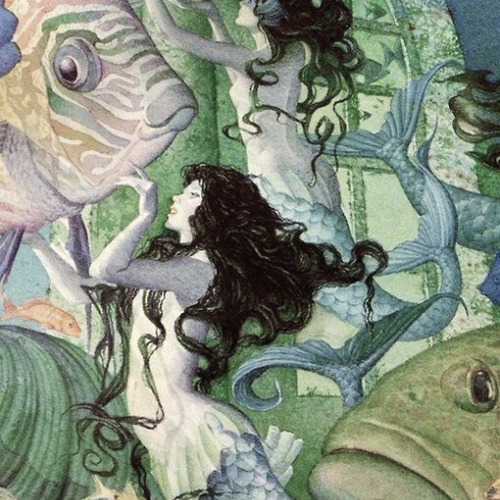
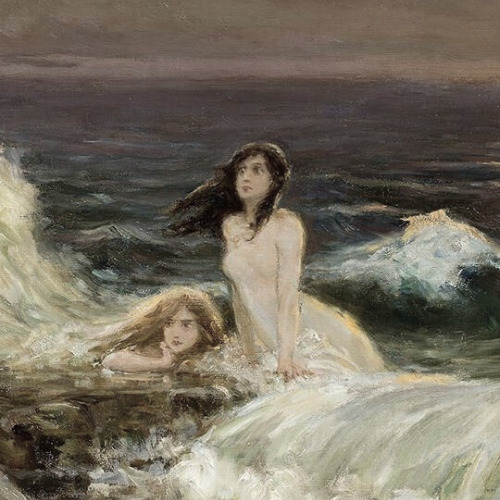

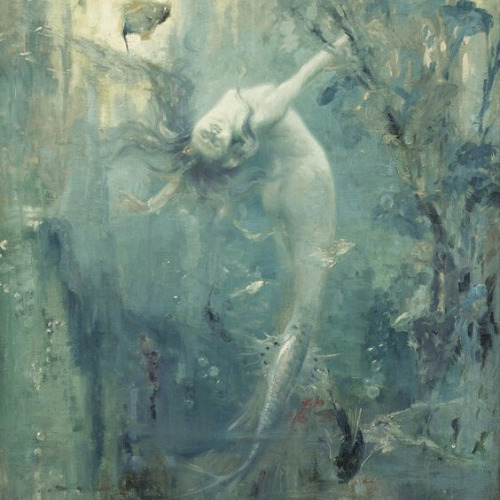

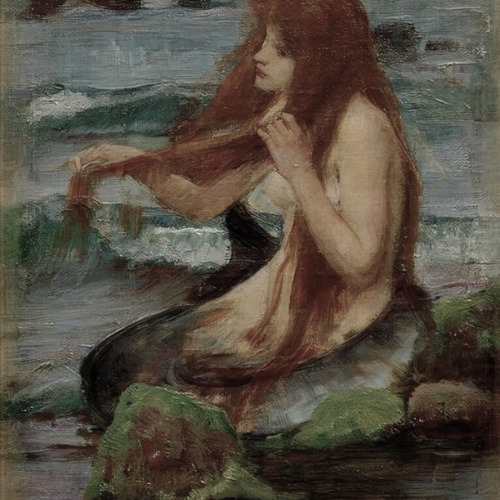

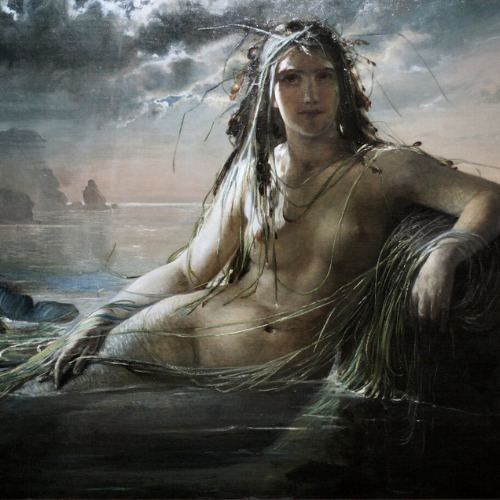
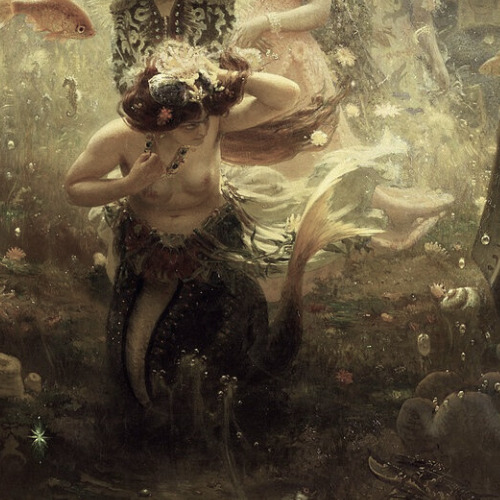

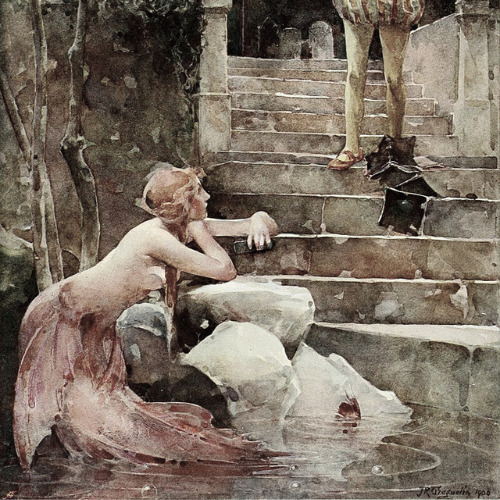


creatures in art: mermaids & sirens
#artist is herbert james draper#artist is john william waterhouse#artist is howard pyle#artist is frederic leighton#artist is edward burne jones#artist is gustav wertheimer#artist is henry paul perrault#artist is hermann corrodi#artist is evelyn de morgan#-artist is john william waterhouse#artist is sir edward john poynter#artist is eilhu vedder#artist is jean-francis auburtin#artist is sir james jebusa shannon#artist is charles santore#artist is wilhelm kotarbinski#artist is unknown#artist is gaston hoffmann#artist is ferdinand leeke#artist is john william waterhouse--#artist is edward frederick brewtnall#artist is elisabeth jerichau-baumann#artist is llya repin#artist is john collier#artist is john reinhard weguelin#artist is e.s hardy#artist is unknown-#art history#art#artedit
2K notes
·
View notes
Text
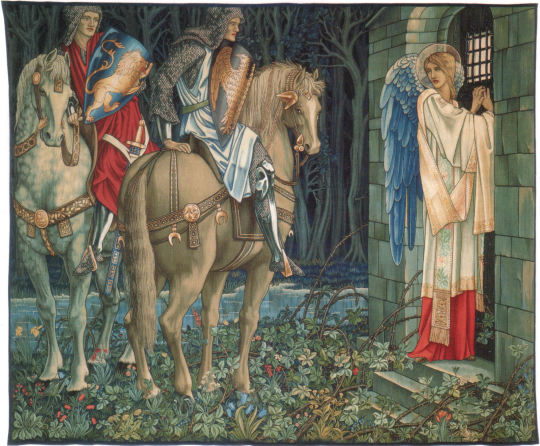
The Failure of Sir Gawaine: Sir Gawaine and Sir Uwaine at the Ruined Chapel (Holy Grail Tapestries, #4), woven for Lawrence Hodson of Compton Hall, 1895-96. Overall design and figures by Sir Edward Burne-Jones; overall design and execution by William Morris; flowers and decorative details by John Henry Dearle. Now in the Birmingham Museum and Art Gallery, Birmingham, England, UK.
#art#art history#Arthuriana#Arthurian legend#Arthurian mythology#Grail Cycle#Sir Gawain#tapestry#weaving#fiber arts#Edward Burne-Jones#William Morris#John Henry Dearle#British art#English art#19th century art#Victorian period#Victorian art#Birmingham Museum and Art Gallery
272 notes
·
View notes
Photo
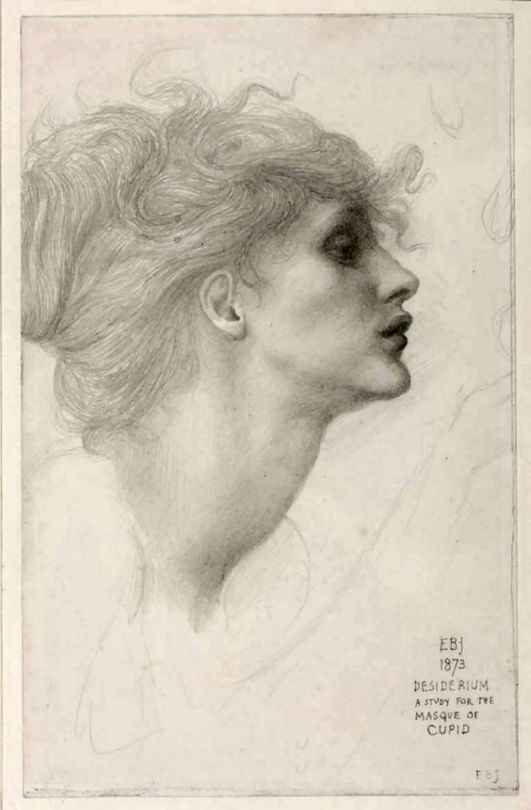

(via Sir Edward Coley Burne-Jones Valentin Serov - portrait of… - all things amazing — LiveJournal)
Sir Edward Coley Burne-Jones
Valentin Serov - portrait of Izabella Grunberg
#Sir Edward Coley Burne-Jones#art#vintage#portraits#women#Valentin Serov#portrait of Izabella Grunberg#1873#desiderium#a study for the masque of cupid
94 notes
·
View notes
Text

The Burne-Jones agenda: Gawain had an emo phase
#Standing in a halo of sunlight listening to MCR on his earbuds and killing people#Terrifying#burne-jones#edward coley burne-jones#gawain#sir gawain#arthuriana#art#arthurian art#pre raphaelite
24 notes
·
View notes
Text

Evening, The Evening Star, Hesperus, Vesper
Artist: Sir Edward Coley Burne-Jones (1833-1898)
Date: 1870
Medium: Watercolour, bodycolour and gum arabic on paper
Collection: Private Collection
The picture has had several names. Burne-Jones called it Vesper in his work-record but exhibited it as Evening. More recently it has been known as Hesperus or The Evening Star. Whatever its title, it belongs to a group of works of the 1870s in which the artist explored the idea of representing cosmic subjects by allegorical figures floating in the night sky.
#painting#fine art#sir edward coley burne jones#allegorical art#hesperus#the evening star#19th century painting#pre raphaelite brotherhood#english painter#floating#mountains#green#watercolour#pre raphaelite art#artwork#allegorical figure#landscape#drapery#english culture#english art#european art
8 notes
·
View notes
Text

Desiderium, a study for the masque of cupid by Sir Edward Coley Burne-Jones (via adski-kafeteri)
27 notes
·
View notes
Text

Cupid and Psyche - Palace Green Murals - Psyche set by Venus the Task
Artist: By Sir Edward Burne-Jones and Walter Crane
Date: 1881
Medium: Oil on canvas
Collection: Birmingham Museums Trust, Birmingham, England, United Kingdom
Description
A scene from William Morris' epic poem, 'The Earthly Paradise'.
#painting#cupid#psyche#pre raphaelite movement#oil on canvas#english culture#fine art#oil painting#artwork#roman mythology#waving#mythological scene#epic poetry#the earthy paradise#underworld#landscape#marble bench#horsemen#classical mythology#male figures#female figures#english art#sir edward burne jones#walter crane#pre raphaelite brotherhood#19th century painting#birmingham museums trust
25 notes
·
View notes
Text

Cupid's Hunting Fields
Artist: Sir Edward Burne-Jones (English, 1833-1898)
Date: 1885
Medium: Gouache, with watercolor and gold and silver paints on ivory wove paper, laid down on linen canvas
Collection: Art Institute of Chicago, Chicago, IL, United States
#mythological art#sir edward burne jones#english artist#gouache#watercolor#european art#cupid#female figures#bow#blinded#arts and crafts movement#female quarry#19th century art
10 notes
·
View notes
Text





The Arming and Departure of the Knights by Edward Burne-Jones
The Summons by Edward Burne-Jones
"[Lancelot] killed Sir Agrawaine with his first blow, and in a few minutes twelve dead bodies lay around him." Andrew Lang's Tales of the Round Table (1908)
The Book of Sir Lancelot: Lancelot killing Sir Agravain. 15th century manuscript, B.N., Paris
The Royal Navy military transport HMT Sir Agravaine during World War II
#edward burne-jones#sir agravaine#sir agravain#sir lancelot#arthurian legend#knights of the round table
6 notes
·
View notes
Text
Wrong side of history. Wrong side of science. Wrong side of Reality.
https://www.telegraph.co.uk/news/2025/04/16/the-famous-faces-who-insisted-trans-women-are-women/
By Fiona Parker April 16, 2025
From politicians to celebrities, many of the great and the good have taken up the trans debate with gusto.
Following Wednesday’s Supreme Court ruling that a trans woman is legally not a woman, here are some of the leading figures who have insisted the opposite, or claimed they must have access to spaces traditionally reserved for females.
Owen Jones
The Guardian columnist has frequently spoken out on the gender debate.
In a 2019 column on the dwindling number of public lavatories, he wrote: “Twenty-first-century toilet provision must cater for gender-neutral spaces and ensure that the rights of trans people are protected too.”
Daniel Radcliffe
The star of the Harry Potter film series was at the centre of a row with JK Rowling in 2020 over the writer’s stance on gender.
He said: “Transgender women are women. Any statement to the contrary erases the identity and dignity of transgender people.”
Sir Keir Starmer
The Prime Minister appears to have changed his views on the gender debate over the years.
In 2022, the then Labour leader said: “A woman is a female adult, and, in addition to that, trans women are women, and that is not just my view, that is actually the law”.
Jameela Jamil
The actress and presenter suggested debates about transgender women in sport were being used to “distract” from the rollback of abortion rights.
As part of a tweet in 2022, she wrote: “Our uteruses are being controlled by the government but no no, let’s keep distracting ourselves with the vast minority that is trans women in sports.”
Emma Watson
The actress who played Hermione Granger in the Harry Potter films was also involved the row with Rowling. In 2020, Watson tweeted: “Trans people are who they say they are and deserve to live their lives without being constantly questioned.”
Rupert Grint
The actor, who played Ron Weasley, joined his Harry Potter co-stars in speaking out on the transgender debate in 2020. He said: “I firmly stand with the trans community.
“Trans women are women. Trans men are men. We should all be entitled to live with love and without judgement.”
Sir Elton John
The musician said gender-critical comments made by Germaine Greer had shown her to be “an attention seeker” in an interview with Emily Maitlis in 2015.
David Tennant
The former Doctor Who star said Kemi Badenoch, then-equalities minister, should “shut up” about her views on transgender people.
Accepting an award for “celebrity ally” at the British LGBT Awards in 2024, Tennant said: “Until we wake up and Kemi Badenoch doesn’t exist any more – I don’t wish ill of her, I just wish her to shut up – whilst we do live in this world, I am honored to receive this [award].”
Kylie Minogue
The pop star briefly addressed a question on single-sex spaces when interviewed by the Guardian in 2020.
She said: “If you’re a transgender woman, you should use the women’s facilities, surely?” before redirecting the conversation.
Eddie Redmayne
The British Star was nominated for an Oscar for his role as transgender Lili Elbe in the 2015 film The Danish Girl.
However, in 2021, he said it was a “mistake” for him to take on the role as a “cisgender” actor.
He said: “No, I wouldn’t take it on now. I made that film with the best intentions, but I think it was a mistake.”
Jolyon Maugham KC
Jolyon Maugham described LGB Alliance as a “transphobic hate group”. Mr Maugham, who founded Good Law Project, told Pink News in 2021: “I strongly encourage you to quote me calling the LGB Alliance a transphobic hate group.” LGB Alliance is an advocacy group which describes itself as “asserting the right of lesbians, bisexuals and gay men to define themselves as same-sex attracted”.
Zendaya
Zendaya told Vogue that feminism should be inclusive of “all women” including trans women. Speaking to the magazine in 2021, the actress said true feminism must encompass “women that look like you, women who don’t look like you, women whose experiences are different than you”.
She continued: “That means black women, that means trans women, that means all women.”
Jedward
The X Factor stars, whose real names are John and Edward Grimes, also waded into the JK Rowling row in 2020 following the publication of her book ‘Troubled Blood’. Tweeting from their official account, the brothers wrote: “Does anyone need firewood this winter! JK’s new book is perfect to burn next to a romantic fire. Aww get all cozy and comfy can’t wait.”
Lily Allen
The outspoken singer posted a meme, a visual joke, in 2015 which pointed to a brain stating “gender is up here” and then to a pair of underpants that said “not down there”.

Jeremy Corbyn
Jeremy Corbyn was leader of the Labour Party in 2018 when he told the BBC that “the position of the party is that where you have self-identified as a woman, then you are treated as a woman”.
#UK#Owen Jones supported men's access to women's bathrooms#Daniel Radcliffe and the trans cult#At least Sir Keir Starmer later acknowledged that woman means adult human female#Jameela Jamil is ok with women's sports prizes going to men#Emma Watson was the UN Ambassador on women's issues yet bowed ro the trans cult#Rupert Grint and the trans cult#Sir Elton John called a woman speaking up for women's rights an attention seeker#David Tennant was so woke he told a woman of color ro shut up#Kylie Minogue has the means to ensure her privacy but other women should be fine with men in womens spaces#Eddie Redmayne thinks the role of a man who transitioned should have been played by a woman#Jolyon Maugham thinks it's hateful and Lesbians Gays and Bisexuals are saying no to the TQ+#Zendaya wants to be applauded for stating a watered down version of feminism#John and Edward Grimes suggested book burning#If Jeremy Corbyn really treated men in dresses like women who won't do whatever they wanted#Lily Allen doesn't understand same sex attraction
2 notes
·
View notes
Text






holy grail tapestries by sir edward burne-jones depicting scenes from the legend of king arthur and the quest for the holy grail
#holy grail#arthurian mythology#sir edward burne-jones#art#art history#artedit#arthistoryedit#ugh the last one is blurry
240 notes
·
View notes
Text

Sir Edward Coley Burne-Jones (English, 1833 – 1898) The Angels of the Hierarchy – Cherubim (1873).
4 notes
·
View notes
Text

'Justice', Study for a stained glass window in Kolkata Cathedral
Sir Edward Burne-Jones
9 notes
·
View notes